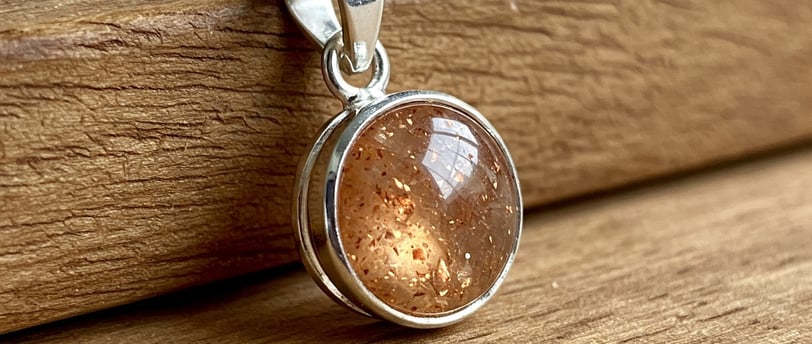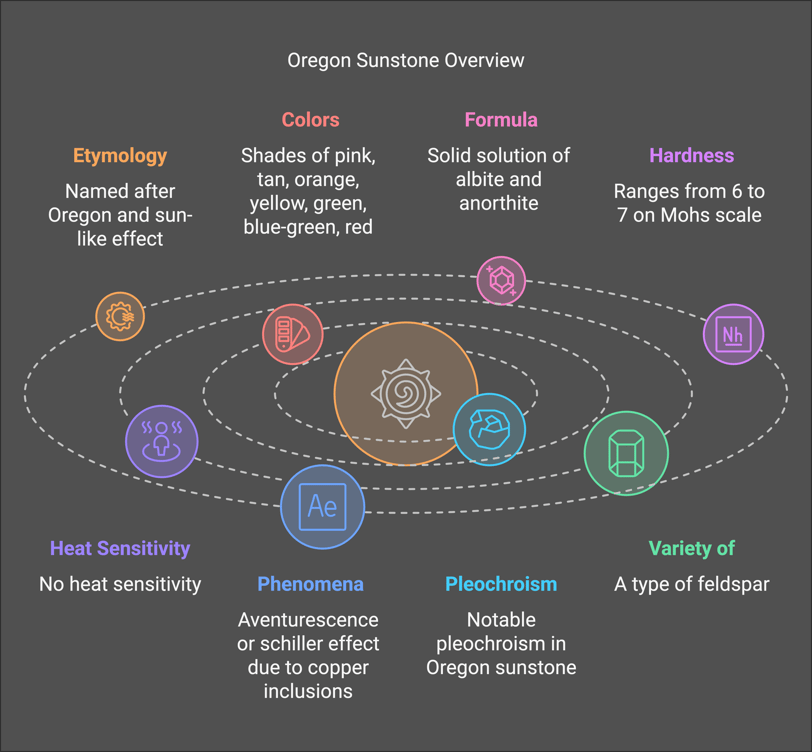Sunstone
Oregon sunstone, a captivating variety of labradorite feldspar, is an all-American gem prized for its distinctive beauty. These gemstones occur in a range of colours, with deep red, deep green, and intensely bi-coloured stones being the most highly valued.
1/30/20254 min read


History
The captivating allure of sunstone has intrigued people for centuries. One of the earliest recorded instances of this gem's appeal dates back to the 16th century when Pope Clement VII was said to possess a sunstone featuring a "golden spot that moved in relation to the heavens". Although sunstone has been valued and traded by Native Americans in the Pacific Northwest for a long time, it is a relative newcomer to the broader gem buying public. Oregon officially declared it its state gemstone in 1987. In the realm of birthstone mythology, sunstones are considered the phenomenal birthstone for those born on Sunday.
Gemstone Mineral Origins
Sunstone is a member of the feldspar group of minerals. It can be found in various locations, including the United States, Mexico, China, Namibia, and Madagascar. Oregon sunstone, specifically, is a variety of labradorite, which is part of the plagioclase feldspar solid-solution series. The chemical composition of Oregon sunstone is about 32% albite (NaAlSi3O8) and 68% anorthite (CaAl2Si2O8). What makes Oregon sunstone unique is the presence of copper inclusions, which can give the gem a shimmering effect known as adventurescence or schiller. The schiller effect is caused by flat, reflective inclusions. While other feldspar sunstones may have hematite or goethite inclusions, Oregon sunstones are the only ones with copper inclusions. These copper inclusions are natural and not the result of any enhancements or treatments. Oregon sunstone is sourced from basalt flows. Most of the material is mined on private claims, but there is also a public Sunstone Collection Area in Lake County, Oregon.
The 4 C’s
Colour
Colour is the most significant factor when assessing the quality of a sunstone. Sunstones occur in a wide variety of colours, including shades of pink, tan, orange, yellow, green, blue-green, red, and clear. Some stones are bicoloured or tricoloured, and a very few even display colour change. The most sought-after sunstone colours are deep red, deep green, and intensely bicoloured. Red Oregon sunstones are sometimes marketed as "spinel red" because their vivid hue can rival that of spinel and ruby. The best greens are very rare and may be even more costly than the best reds. Some sunstones display a phenomenon called pleochroism, which means that they can display different colours when viewed from different angles.
Clarity
All Oregon sunstones have a unique sheen caused by copper inclusions. Even if these inclusions aren't large enough to create a visible aventurescence, they still contribute to the gem's overall appearance. The presence of copper inclusions is a key identifier of Oregon sunstone. Some stones may have visible schiller inclusions of copper and lead, which can range from an iridescent shimmer to a dull and lifeless look. Lower quality stones may have bold inclusions or appear muted.
Carat
Sunstones come in a wide range of sizes. Smaller stones under one carat are frequently cut into calibrated sizes for standard jewellery mountings. Larger faceted stones are less common, but gem carvers often use larger, non-facet-grade material to create unique pieces. Larger stones with intense colour may be quite valuable.
Cut
Sunstone is a versatile material that is cut into a variety of shapes. The cut of a sunstone can be a key contributor to its overall appearance. Cutters often design unique cuts to highlight the gem's unique colour and optical effects. Fine Oregon sunstones respond very well to faceting, while lower-quality stones are often shaped into cabochons or beads.
Be Aware of
Enhancements
Oregon sunstone is not known to be enhanced or treated. It acquires its copper inclusions naturally. However, other feldspar sunstones from other regions might be enhanced by adding copper through heating and pressure treatments.
Simulants
Be cautious of goldstone, a synthetic material made of glass with copper inclusions that is often used as a simulant for sunstone. A gemmologist will be able to easily distinguish a natural sunstone from goldstone.
Synthetics
Oregon sunstones have not been synthesised.
Final Thoughts
Buying Tips
Be wary of purchasing Oregon sunstones online due to the challenges of accurately photographing their pleochroism, which is the display of two or three distinct colors when viewed from different angles. Also, remember that dealers often price their inventory based on beauty, which can be quite subjective. It is important to look for a reputable dealer, preferably one with a physical retail location. When buying, consider that the price range for schiller stones is generally between $38 and $70 per carat, regardless of size or colour. Clear hues range from $20 to $242 per carat, depending on size and quality. Mid-deep tones range from $114 to $405 per carat, depending on size and colour. Constellation stones range from $78 to $109 per carat. Dichroic stones range from $84 to $355 per carat. Classic sunstones range from $50 to $189 per carat. Mystique stones range from $391 to $1,226 per carat.
Jewellery Care
Oregon sunstones are best suited for jewellery that does not experience heavy wear, such as pendants, earrings, and brooches, due to their hardness of 6 to 6.5 on the Mohs scale. The best cleaning method for sunstones is warm, soapy water and a soft brush. Avoid mechanical cleaning methods like ultrasonic systems and steam. Be careful not to scratch the gem by storing it away from other jewellery.


Gemius Stones
Expertise
© 2025. All rights reserved.
